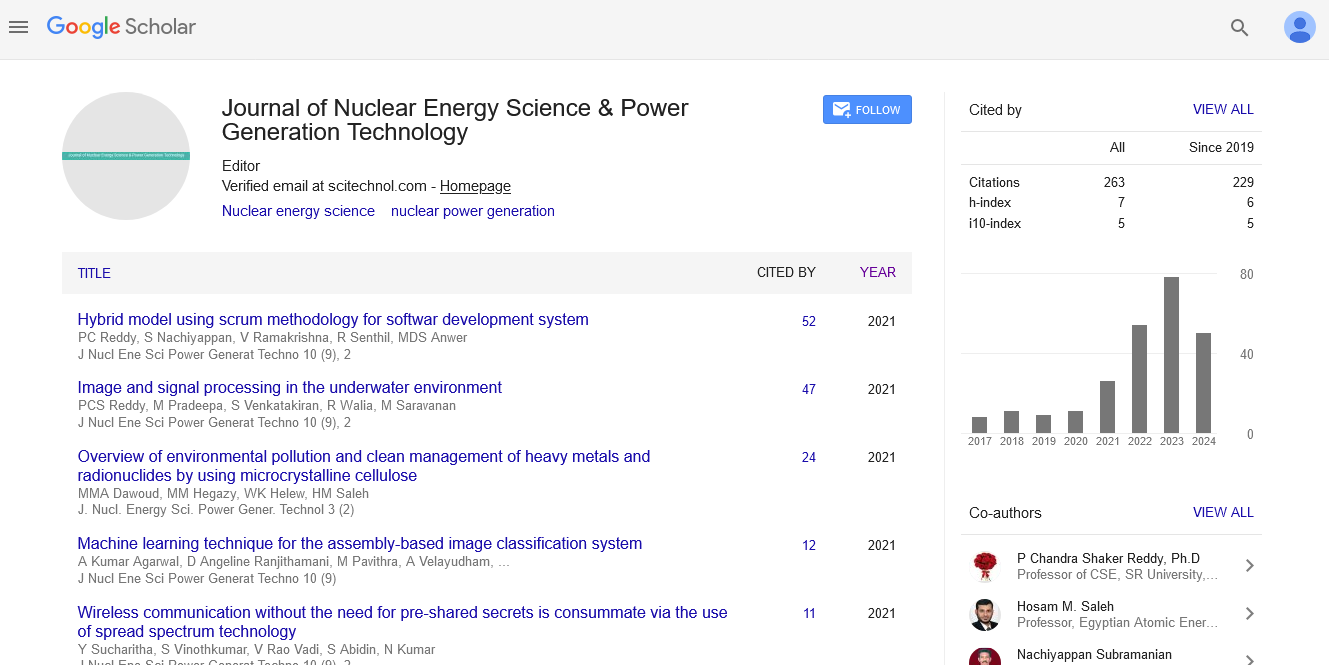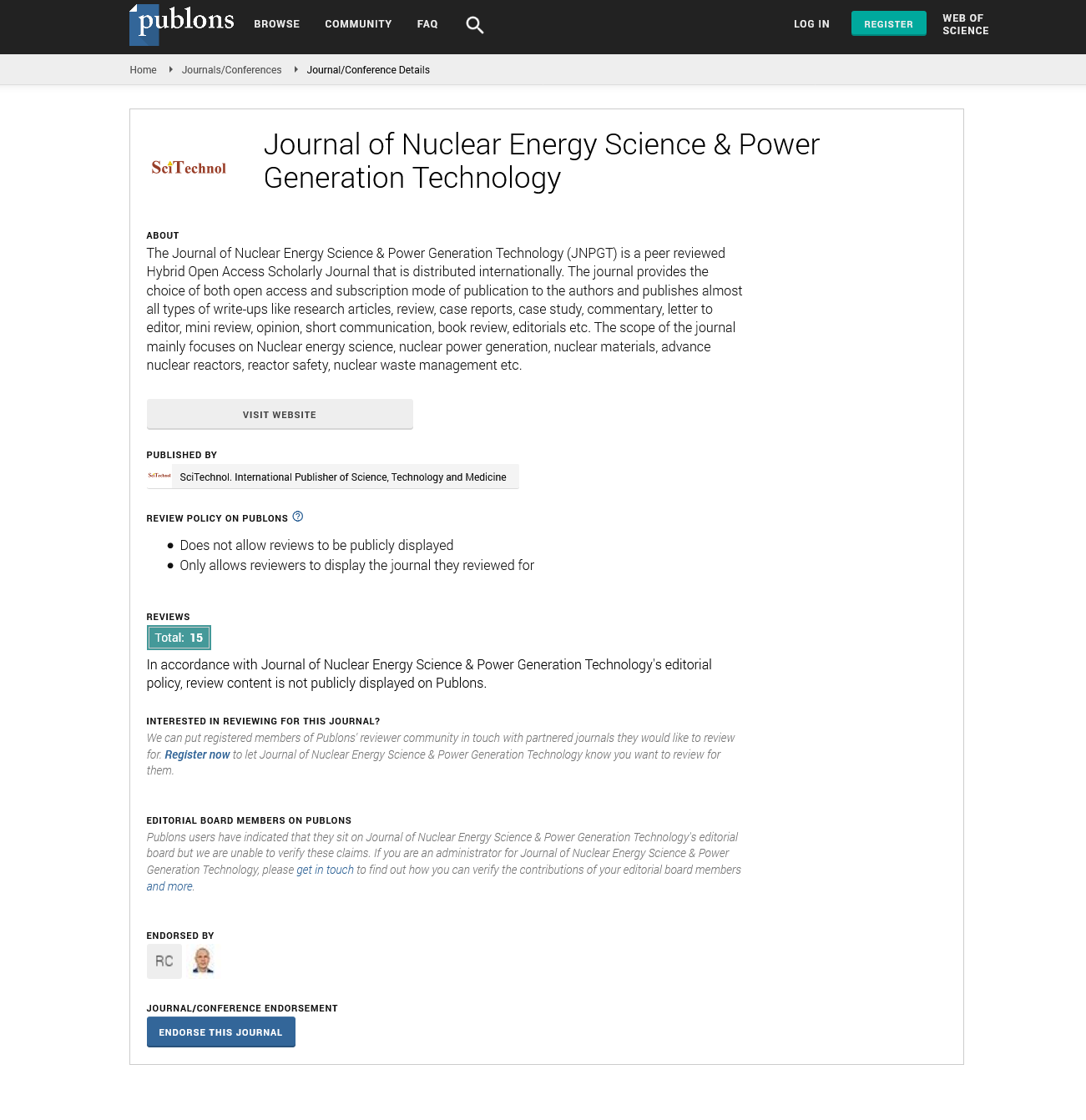Opinion Article, J Nucl Ene Sci Power Generat Technol Vol: 13 Issue: 4
Dynamic Function of Reactor Coolant Pumps in Nuclear Power Plants
Ruiwe Fuisa*
1Department of Energy Systems Engineering, Erciyes University, Kayseri, Turkey
*Corresponding Author: Ruiwe Fuisa,
Department of Energy Systems Engineering,
Erciyes University, Kayseri, Turkey
E-mail: ruiwe_fuisa123@gmail.com
Received date: 17 June, 2024, Manuscript No. JNPGT-24-143341;
Editor assigned date: 19 June, 2024, PreQC No. JNPGT-24-143341 (PQ);
Reviewed date: 03 July, 2024, QC No. JNPGT-24-143341;
Revised date: 11 July, 2024, Manuscript No. JNPGT-24-143341 (R);
Published date: 18 July, 2024, DOI: 10.4172/2325-9809.1000407.
Citation: Fuisa R (2024) Dynamic Function of Reactor Coolant Pumps in Nuclear Power Plants. J Nucl Ene Sci Power Generat Technol 13:4.
Description
Reactor Coolant Pumps (RCPs) are vital components in the operation of nuclear power plants, playing an essential role in maintaining the cooling process necessary for safe and efficient reactor performance. These pumps circulate the reactor coolant through the core, transferring the heat generated by nuclear fission to steam generators or directly to the turbines in the case of boiling water reactors. Understanding the design, function, and importance of RCPs is vital for appreciating their role in the overall safety and efficiency of nuclear power generation the reactor core produces a tremendous amount of heat through the fission of nuclear fuel. This heat must be effectively removed to prevent overheating and potential damage to the reactor. Reactor coolant pumps are responsible for this task by ensuring the continuous flow of coolant, typically water, through the reactor core and associated heat exchange systems. In pressurized water reactors, the RCPs circulate the coolant at high pressure to prevent it from boiling. The heat is then transferred to a secondary loop via steam generators, where it is used to produce steam that drives the turbines to generate electricity. In boiling water reactors, the coolant is allowed to boil within the reactor core, and the produced steam is directly used to drive the turbines.
The design and operation of reactor coolant pumps are dictated by the demanding conditions they must endure. These pumps operate under high temperatures, high pressures, and intense radiation fields, requiring robust construction and precise engineering. Typically, RCPs are vertical, centrifugal pumps driven by powerful electric motors. The materials used in their construction, such as stainless steel and other corrosion-resistant alloys, are chosen for their ability to withstand the harsh operating environment. One of the primary challenges in designing reactor coolant pumps is ensuring their reliability and durability. A failure in an RCP can lead to a loss of coolant flow, which, if not promptly addressed, could result in overheating of the reactor core and potentially catastrophic consequences. Therefore, RCPs are built with multiple safety features and redundancy to ensure continuous operation. This includes the use of backup pumps, emergency power supplies, and advanced monitoring systems to detect and respond to any signs of malfunction or wear.
The operation of reactor coolant pumps is also vital for maintaining the overall efficiency of the nuclear power plant. The flow rate of the coolant must be carefully controlled to optimize heat transfer and ensure the reactor operates within safe temperature limits. Too little coolant flow can lead to insufficient cooling, while too much flow can reduce the efficiency of the heat transfer process. Advanced control systems are employed to regulate the speed and performance of the RCPs, adapting to changes in reactor power output and operational conditions.
In addition to their primary function of circulating coolant, reactor coolant pumps also play a role in the overall safety systems of a nuclear power plant. During normal operation, they help maintain the pressure and temperature within the reactor's primary loop. In the event of an emergency, such as a loss-of-coolant accident the RCPs work in conjunction with other safety systems to provide continued cooling and prevent core damage. For example, in PWRs, the pumps can be used to maintain natural circulation cooling, where the coolant continues to flow through the reactor core and steam generators due to the density differences between hot and cold coolant.
Conclusion
In conclusion, reactor coolant pumps are indispensable components of nuclear power plants, ensuring the safe and efficient removal of heat from the reactor core. Their design, operation, and maintenance are vital for the overall performance and safety of nuclear reactors. By providing continuous and reliable coolant circulation, RCPs play a vital role in binding nuclear energy to generate electricity, contributing to the stability and sustainability of our energy supply. The maintenance and monitoring of reactor coolant pumps are important aspects of nuclear power plant operation. Regular inspections, testing, and preventive maintenance are conducted to ensure the pumps remain in optimal condition. Advanced diagnostic tools and techniques, such as vibration analysis and thermal imaging, are used to detect early signs of wear or failure, allowing for timely maintenance and repairs.
 Spanish
Spanish  Chinese
Chinese  Russian
Russian  German
German  French
French  Japanese
Japanese  Portuguese
Portuguese  Hindi
Hindi 

